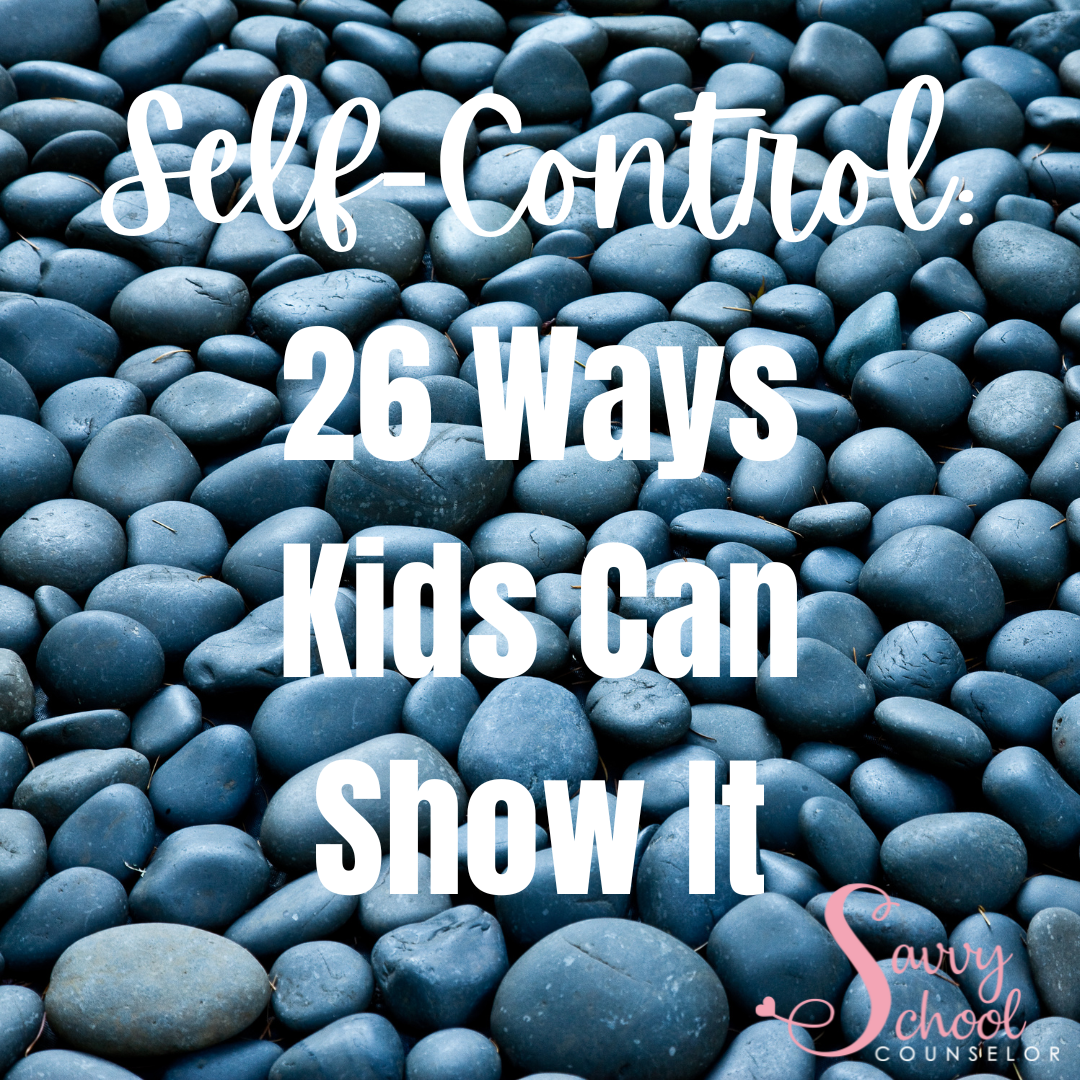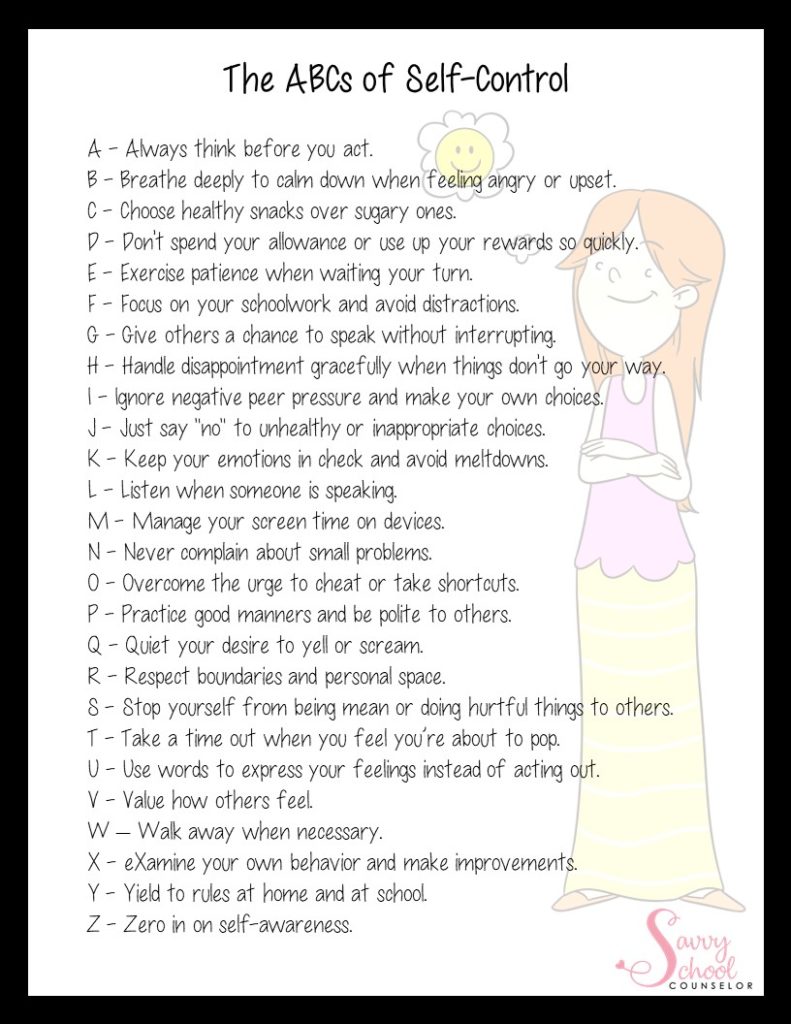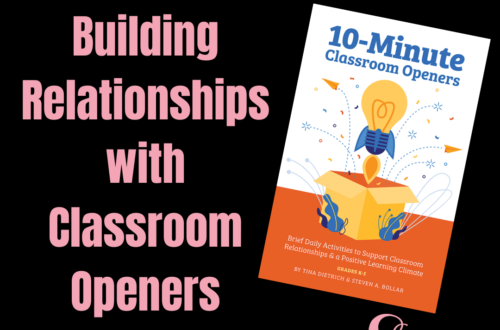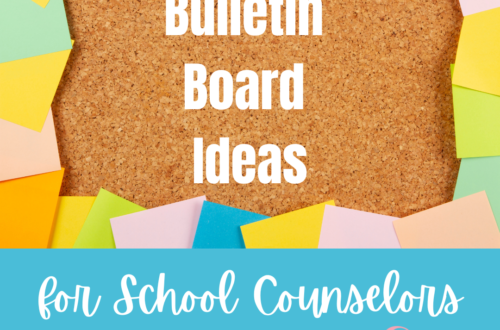
Self-Control: 26 Ways Kids Can Show It
As the school year progresses and students feel more “at home” and comfortable at school, you may see less self-control and more issues arising or teacher concerns centered around student impulsivity and inappropriate school behaviors. From kids needing self-regulation skills to those making poor choices and not thinking before they act, you will likely find yourself addressing self-control in your class lessons, small groups, or individual sessions.
Today, in a similar fashion to my post Kindness: 26 Ways Kids Can Show It, I’ll be sharing the ABCs of Self-Control. Children with self-control are better able to make good decisions, manage their emotions, and achieve their goals. So check out each letter and look for a FREE printable at the end to share with your students!
The ABCs of Self-Control
A – Always think before you act.
Think about your choices before you make them. If the end result won’t be a good one, DON’T do it!
B – Breathe deeply to calm down when feeling angry or upset.
When you feel those strong emotions, show self-control by taking deep breaths to calm down and prevent making poor choices.
C – Choose healthy snacks over sugary ones.
It takes self-control to choose healthy foods over sugary or unhealthy snacks. Try to make responsible choices more often.
D – Don’t spend your allowance or use up your rewards so quickly.
Start the habit of saving now. Just because you have it doesn’t mean you should use it immediately. Use your self-control and put some away for a long-term goal.
E – Exercise patience when waiting your turn,
Show how patient you can be by waiting calmly in line or for your turn to do something. Try not to get so frustrated when your turn takes a little longer than you’d like.
F – Focus on your schoolwork and avoid distractions,
When it’s time to work, be sure to concentrate on your assignments. Do not get distracted by things in or on your desk or by classmates who may want to talk to you. Stay focused!
G – Give others a chance to speak without interrupting.
Even though you have a thought you want to share, be sure to wait until no one is talking so you don’t interrupt the person who is speaking. You’ll get the chance to share before you know it!
H – Handle disappointment gracefully when things don’t go your way.
Everything won’t always go the way you want it to. When it doesn’t, show your good character instead of reacting with anger or having a meltdown.
I – Ignore negative peer pressure and make your own choices.
Just because someone makes a choice, it doesn’t mean you should do the same. You don’t have to follow the crowd. Resist peer pressure and make your own decisions.
J – Just say “no” to unsafe or inappropriate choices.
Self-control helps you to say no to choices that are unhealthy or unsafe. If you know something is bad for you or could be dangerous, don’t participate.
K – Keep your emotions in check and avoid meltdowns.
When you show self-control, you are able to manage your big emotions. This is very important when you experience anger and frustration. When you are able to stay calm and control your feelings, you will have fewer meltdowns.
L – Listen when someone is speaking.
When you pay attention while someone speaks, you are showing self-control. This is super important when you are learning in school.
M – Manage your screen time on devices.
As much as you may enjoy using your tablet, computer, or game console, self-control happens when you don’t overdo it. Limit your screen time!
N – Never complain about small problems.
Don’t whine and complain about small problems. When a small issue comes up, use your self-control and display patience. It’s only temporary.
O – Overcome the urge to cheat or take shortcuts.
Honesty and hard work are the best ways to achieve success. When you resist the temptation to cheat on a test or in a game, you are showing self-control.
P – Practice good manners and be polite to others.
When talking to adults, family, classmates, or friends, always show how polite you can be. Control the words you use and always show respect. If you have a disagreement, choose your words wisely.
Q – Quiet your desire to yell or scream.
When something happens that triggers your big emotions, use your calming strategies to help control your behavior instead of yelling about the situation or at someone.
R – Respect boundaries and personal space.
Pay attention to other people’s personal space. When you show that you respect other people’s boundaries, you are demonstrating your self-control.
S – Stop yourself from being mean or doing hurtful things to others.
Avoid participating in negative behaviors like teasing or bullying others. Saying mean things and hurting others’ feelings on purpose are poor choices.
T – Take a time out when you feel you’re about to pop.
When you feel stressed or overwhelmed, take some time alone to cool off. You can even try taking a deep breath and counting to ten. Once you’ve calmed down, you’ll be better able to express your feelings.
U – Use words to express your feelings instead of acting out.
Having a meltdown is never the best way to show how you are feeling. Instead, show self-control by using your words to express your emotions instead of turning to negative behaviors.
V – Value how others feel.
You’ll show that you have control by respecting how others feel and not just focusing on yourself. Just like you want to be heard, others want to be listened to as well.
W – Walk away when necessary.
It definitely takes self-control to walk away from a situation. Walking away can help you to avoid conflict and to stay safe. Knowing your triggers can be very helpful so you know when it’s time to take a step back.
X – eXamine your own behavior and make improvements.
When you have self-control, you are able to notice things you need to do better with. Once you choose where you need to work, whether it’s your behavior or even your school work, take time each day to make improvements so you can become better.
Y – Yield to rules at home and at school.
In other words, follow the rules wherever you are. When you do this, you are showing self-control by doing what you are supposed to and not doing the things you shouldn’t.
Z – Zero in on self-awareness.
When you are self-aware, you recognize your own feelings and triggers. Once you zero in, you’ll know exactly where you can improve your self-control.
Teaching kids self-control can help them make better choices, manage their emotions, and build strong character as they grow.
Here is a FREE DOWNLOAD of The ABCs of Self-Control for you to use with your students. You can also check out The Self-Discipline Files in my TPT store.
Stick around! You can follow Savvy School Counselor with free email updates. You can also follow my TpT Store to keep up with my latest products and freebies. Additionally, I do giveaways through My Facebook Page with my new products. Be sure to like Savvy School Counselor on Facebook and click to receive notifications so you don’t miss them!
Related Posts via Categories






